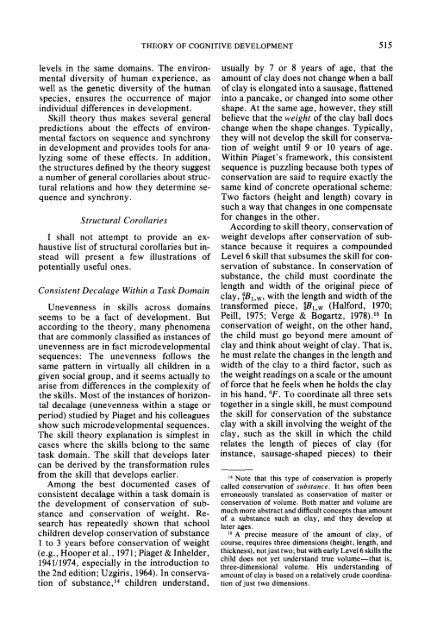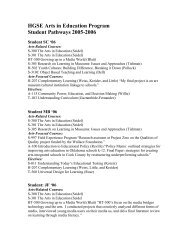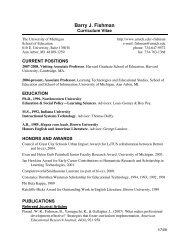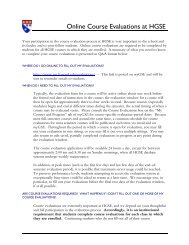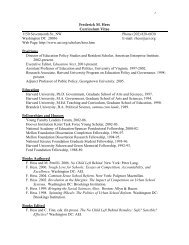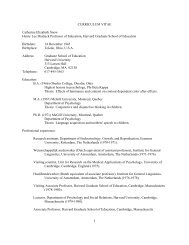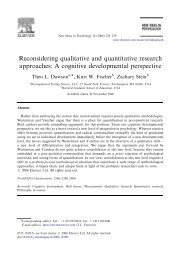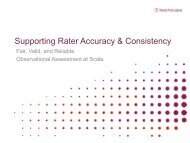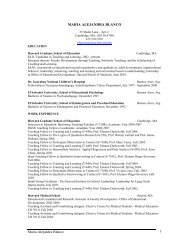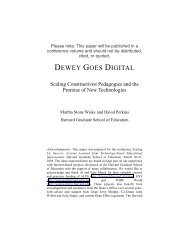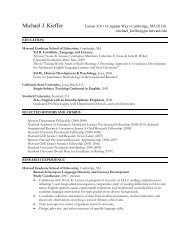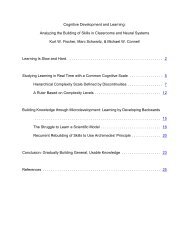Psychological Review - Harvard Graduate School of Education ...
Psychological Review - Harvard Graduate School of Education ...
Psychological Review - Harvard Graduate School of Education ...
Create successful ePaper yourself
Turn your PDF publications into a flip-book with our unique Google optimized e-Paper software.
THEORY OF COGNITIVE DEVELOPMENT 515<br />
levels in the same domains. The environmental<br />
diversity <strong>of</strong> human experience, as<br />
well as the genetic diversity <strong>of</strong> the human<br />
species, ensures the occurrence <strong>of</strong> major<br />
individual differences in development.<br />
Skill theory thus makes several general<br />
predictions about the effects <strong>of</strong> environmental<br />
factors on sequence and synchrony<br />
in development and provides tools for analyzing<br />
some <strong>of</strong> these effects. In addition,<br />
the structures defined by the theory suggest<br />
a number <strong>of</strong> general corollaries about structural<br />
relations and how they determine sequence<br />
and synchrony.<br />
Structural Corollaries<br />
I shall not attempt to provide an exhaustive<br />
list <strong>of</strong> structural corollaries but instead<br />
will present a few illustrations <strong>of</strong><br />
potentially useful ones.<br />
Consistent Decalage Within a Task Domain<br />
Unevenness in skills across domains<br />
seems to be a fact <strong>of</strong> development. But<br />
according to the theory, many phenomena<br />
that are commonly classified as instances <strong>of</strong><br />
unevenness are in fact microdevelopmental<br />
sequences: The unevenness follows the<br />
same pattern in virtually all children in a<br />
given social group, and it seems actually to<br />
arise from differences in the complexity <strong>of</strong><br />
the skills. Most <strong>of</strong> the instances <strong>of</strong> horizontal<br />
decalage (unevenness within a stage or<br />
period) studied by Piaget and his colleagues<br />
show such microdevelopmental sequences.<br />
The skill theory explanation is simplest in<br />
cases where the skills belong to the same<br />
task domain. The skill that develops later<br />
can be derived by the transformation rules<br />
from the skill that develops earlier.<br />
Among the best documented cases <strong>of</strong><br />
consistent decalage within a task domain is<br />
the development <strong>of</strong> conservation <strong>of</strong> substance<br />
and conservation <strong>of</strong> weight. Research<br />
has repeatedly shown that school<br />
children develop conservation <strong>of</strong> substance<br />
1 to 3 years before conservation <strong>of</strong> weight<br />
(e.g., Hooper et al., 1971; Piaget & Inhelder,<br />
1941/1974, especially in the introduction to<br />
the 2nd edition; Uzgiris, 1964). In conservation<br />
<strong>of</strong> substance, 14 children understand,<br />
usually by 7 or 8 years <strong>of</strong> age, that the<br />
amount <strong>of</strong> clay does not change when a ball<br />
<strong>of</strong> clay is elongated into a sausage, flattened<br />
into a pancake, or changed into some other<br />
shape. At the same age, however, they still<br />
believe that the weight <strong>of</strong> the clay ball does<br />
change when the shape changes. Typically,<br />
they will not develop the skill for conservation<br />
<strong>of</strong> weight until 9 or 10 years <strong>of</strong> age.<br />
Within Piaget's framework, this consistent<br />
sequence is puzzling because both types <strong>of</strong><br />
conservation are said to require exactly the<br />
same kind <strong>of</strong> concrete operational scheme:<br />
Two factors (height and length) covary in<br />
such a way that changes in one compensate<br />
for changes in the other.<br />
According to skill theory, conservation <strong>of</strong><br />
weight develops after conservation <strong>of</strong> substance<br />
because it requires a compounded<br />
Level 6 skill that subsumes the skill for conservation<br />
<strong>of</strong> substance. In conservation <strong>of</strong><br />
substance, the child must coordinate the<br />
length and width <strong>of</strong> the original piece <strong>of</strong><br />
clay, ?BL,W» with the length and width <strong>of</strong> the<br />
transformed piece, i# L w (Halford, 1970;<br />
Peill, 1975; Verge & Bogartz, 1978). 15 In<br />
conservation <strong>of</strong> weight, on the other hand,<br />
the child must go beyond mere amount <strong>of</strong><br />
clay and think about weight <strong>of</strong> clay. That is,<br />
he must relate the changes in the length and<br />
width <strong>of</strong> the clay to a third factor, such as<br />
the weight readings on a scale or the amount<br />
<strong>of</strong>feree that he feels when he holds the clay<br />
in his hand, 6 F. To coordinate all three sets<br />
together in a single skill, he must compound<br />
the skill for conservation <strong>of</strong> the substance<br />
clay with a skill involving the weight <strong>of</strong> the<br />
clay, such as the skill in which the child<br />
relates the length <strong>of</strong> pieces <strong>of</strong> clay (for<br />
instance, sausage-shaped pieces) to their<br />
14 Note that this type <strong>of</strong> conservation is properly<br />
called conservation <strong>of</strong> substance. It has <strong>of</strong>ten been<br />
erroneously translated as conservation <strong>of</strong> matter or<br />
conservation <strong>of</strong> volume. Both matter and volume are<br />
much more abstract and difficult concepts than amount<br />
<strong>of</strong> a substance such as clay, and they develop at<br />
later ages.<br />
15 A precise measure <strong>of</strong> the amount <strong>of</strong> clay, <strong>of</strong><br />
course, requires three dimensions (height, length, and<br />
thickness), not just two; but with early Level 6 skills the<br />
child does not yet understand true volume—that is,<br />
three-dimensional volume. His understanding <strong>of</strong><br />
amount <strong>of</strong> clay is based on a relatively crude coordination<br />
<strong>of</strong> just two dimensions.


